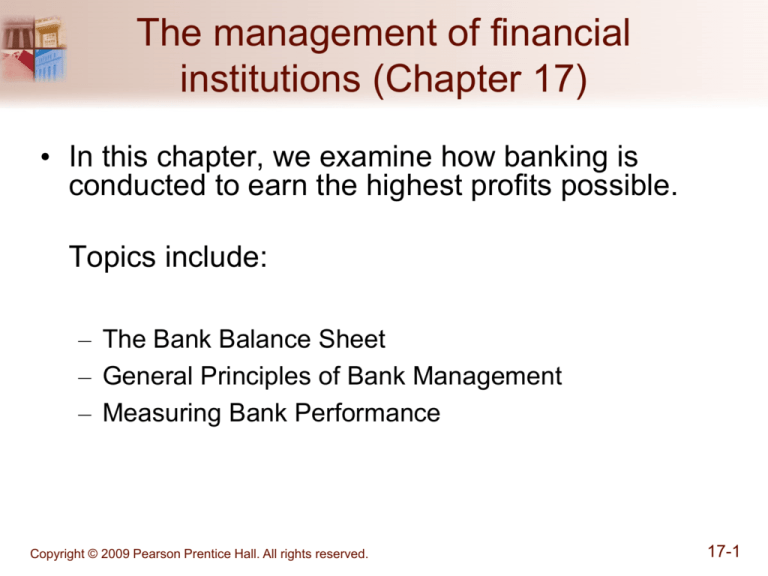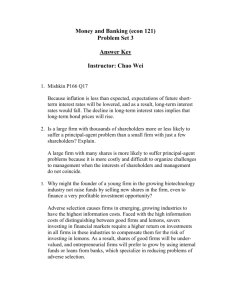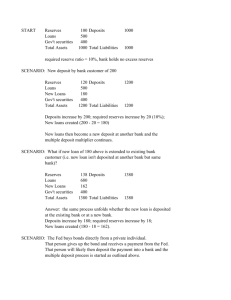
The management of financial
institutions (Chapter 17)
• In this chapter, we examine how banking is
conducted to earn the highest profits possible.
Topics include:
– The Bank Balance Sheet
– General Principles of Bank Management
– Measuring Bank Performance
Copyright © 2009 Pearson Prentice Hall. All rights reserved.
17-1
Exercise
Italian
English
Assegno
Emettere assegni
Prelevare
Versare
Filiale
Prelevamento
Conto corrente
Depositi a risparmio
Copyright © 2009 Pearson Prentice Hall. All rights reserved.
17-2
Exercise
Italian
English
Assegno
Check
Emettere assegni
To write checks
Prelevare
To withdraw
Versare
To deposit
Filiale
Branch
Prelevamento
Withdrawal
Conto corrente
Current account or Checkable deposit
Depositi a risparmio
Savings accounts
Copyright © 2009 Pearson Prentice Hall. All rights reserved.
17-3
The Bank Balance Sheet
• The Balance Sheet is a list of a bank’s
assets and liabilities
• Total assets = total liabilities + capital
Copyright © 2009 Pearson Prentice Hall. All rights reserved.
17-4
The Bank Balance Sheet
• A bank’s balance sheet lists sources of
bank funds (liabilities) and uses to which
they are put (assets)
• Banks invest these liabilities (sources) into
assets (uses) in order to create value for
their capital providers
Copyright © 2009 Pearson Prentice Hall. All rights reserved.
17-5
The Bank Balance Sheet
• The next slide shows the aggregate
balance sheet for all U.S. commercial
banks. We will then step through each
item, discussing each in detail.
Copyright © 2009 Pearson Prentice Hall. All rights reserved.
17-6
The Bank Balance Sheet
Copyright © 2009 Pearson Prentice Hall. All rights reserved.
Flow of funds (tab down to commercial banks)
http://www.federalreserve.gov/releases/z1/
current/z1r-4.pdf
17-7
The Bank Balance Sheet
• The next slide shows the aggregate
balance sheet for all Italian banks (end of
2008).
Copyright © 2009 Pearson Prentice Hall. All rights reserved.
17-8
The Bank Balance Sheet
Assets
%
Liabilities
%
Cash items
0,05
Deposits from
residents
50,5
Securities
5,8
Deposits from
non-residents
17,8
Loans
55,8
Interbank
borrowings
23,1
Interbank loans
22,5
Bank capital
8,6
Equity stakes
4,7
Foreign activities
11,5
Total
100
Total
100
Copyright © 2009 Pearson Prentice Hall. All rights reserved.
17-9
The Bank Balance Sheet:
Liabilities (a)
• Checkable Deposits: includes all accounts that
allow the owner (depositor) to write checks to
third parties;
• Checkable deposits are payable on demand: if a
depositor shows up at the bank and requests
payment by making a withdrawal, the bank must
pay the depositor immediately.
Copyright © 2009 Pearson Prentice Hall. All rights reserved.
17-10
The Bank Balance Sheet:
Liabilities (a)
• Checkable deposits are usually the bank’s
lowest cost funds because depositors want
safety and liquidity and will accept a lesser
interest return from the bank in order to
achieve such attributes.
Copyright © 2009 Pearson Prentice Hall. All rights reserved.
17-11
The Bank Balance Sheet:
Liabilities (b)
• Nontransaction Deposits: are accounts
from which the depositor cannot write
checks; examples include savings accounts
and time deposits (also known as CDs or
certificates of deposit)
• Saving accounts: funds can be added or
withdrawn at any time, transactions and
interest payments are recorded in a
passbook held by the owner of the account
Copyright © 2009 Pearson Prentice Hall. All rights reserved.
17-12
The Bank Balance Sheet:
Liabilities (b)
• Time deposits have a fixed maturity length
and asses substantial penalties for early
withdrawal
• Nontransaction deposits are generally a
bank’s highest cost funds because banks
want deposits which are more stable and
predictable and will pay more to the
depositors (funds suppliers) in order to
achieve such attributes.
Copyright © 2009 Pearson Prentice Hall. All rights reserved.
17-13
The Bank Balance Sheet:
Liabilities (c)
• Borrowings: banks obtain funds by borrowing
from the Federal Reserve System, other banks,
their parent companies (bank holding
companies)…;
Copyright © 2009 Pearson Prentice Hall. All rights reserved.
17-14
The Bank Balance Sheet:
Liabilities (d)
• Bank Capital: is the source of funds
supplied by the bank owners, either directly
through purchase of ownership shares or
indirectly through retention of earnings
(retained earnings being the portion of
funds which are earned as profits but not
paid out as ownership dividends). This is
about 8/9% of assets.
Copyright © 2009 Pearson Prentice Hall. All rights reserved.
17-15
The Bank Balance Sheet:
Liabilities (d)
• Since assets minus liabilities equals capital,
capital is seen as protecting the liability
suppliers from asset devaluations or writeoffs (capital is also called the balance
sheet’s “shock absorber,” thus capital
levels are important).
Copyright © 2009 Pearson Prentice Hall. All rights reserved.
17-16
The Bank Balance Sheet:
Assets (a)
• Reserves: funds held in account with the
Fed (vault cash as well). Required reserves
represent what is required by law under
current required reserve ratios (the bank is
obliged to keep a certain fraction of its
deposits as required reserves).
• Any reserves beyond this area are called
excess reserves (the most liquid of all bank
assets).
Copyright © 2009 Pearson Prentice Hall. All rights reserved.
17-17
The Bank Balance Sheet:
Assets (b)
• Securities: these are either U.S.
government/agency debt, municipal debt,
and other (non-equity) securities. (Banks in
U.S. are not allowed to hold stock)
• Short-term Treasury debt is often referred
to as secondary reserves because of its
high liquidity.
Copyright © 2009 Pearson Prentice Hall. All rights reserved.
17-18
The Bank Balance Sheet:
Assets (c)
• Loans: these are a bank’s income-earning
assets, such as business loans, auto loans,
and mortgages. These are generally not
very liquid. Most banks tend to specialize
in either consumer loans or business loans,
and even take that as far as loans to
specific groups (such as a particular
industry).
Copyright © 2009 Pearson Prentice Hall. All rights reserved.
17-19
The Bank Balance Sheet:
Assets (d)
• Other Assets: bank buildings, computer
systems, and other equipment.
Copyright © 2009 Pearson Prentice Hall. All rights reserved.
17-20
General Principles
of Bank Management
Now let’s look at how a bank manages its assets
and liabilities. The bank has four primary
concerns:
1. Liquidity management
2. Asset management
– Managing credit risk
– Managing interest-rate risk
3. Liability management
4. Managing capital adequacy
Copyright © 2009 Pearson Prentice Hall. All rights reserved.
17-21
Liquidity management
• The first concern is to make sure that the
bank has enough ready cash to pay its
depositors when there are deposit outflows
• Reserves pay no interest, but…
• We assume that the bank has ample
excess reserves and that all deposits have
the same required reserve ratio of 10%
Copyright © 2009 Pearson Prentice Hall. All rights reserved.
17-22
Principles of Bank Management
Liquidity Management
Reserves requirement = 10%, Excess reserves = $10 million
Assets
Liabilities
Reserves
$20 million Deposits
Loans
$80 million Bank Capital
Securities
$10 million
Copyright © 2009 Pearson Prentice Hall. All rights reserved.
$100 million
$10 million
17-23
Principles of Bank Management
Deposit outflow of $10 million
Assets
Liabilities
Reserves
$10 million Deposits
$90 million
Loans
$80 million Bank Capital
$10 million
Securities
$10 million
• If a deposit outflow of $10 million occurs…
• With 10% reserve requirement, bank still has
excess reserves of $1 million: no changes
needed in balance sheet
Copyright © 2009 Pearson Prentice Hall. All rights reserved.
17-24
Liquidity Management
No excess reserves
Assets
Liabilities
Reserves
$10 million Deposits
$100 million
Loans
$90 million Bank Capital
Securities
$10 million
$10 million
Deposit outflow of $10 million
Assets
Reserves
Liabilities
$0 million Deposits
Loans
$80 million Bank Capital
Securities
$10 million
$90 million
$10 million
• With 10% reserve requirement, bank has $9 million
reserve shortfall. To eliminate it the bank has different
basic options
Copyright © 2009 Pearson Prentice Hall. All rights reserved.
17-25
Liquidity Management
1. Borrow from othe r banks or corporations
Assets
Liabilities
Reserves
Loans
$9 million Deposits
$90 million Borrowings
Securities
$10 million Bank Capital
$100 million
$9 million
$10 million
2. Sell securities
Assets
Reserves
Loans
Securities
Liabilities
$9 million Deposits
$90 million Bank Capital
$90 million
$10 million
$1 million
Copyright © 2009 Pearson Prentice Hall. All rights reserved.
17-26
Liquidity Management
3. Borrow from Fed
Assets
Liabilities
Reserves
Loans
$9 million Deposits
$90 million Discount Loans
$90 million
$9 million
Securities
$10 million Bank Capital
$10 million
4. Call in or sell off loans
Assets
Liabilities
Reserves
Loans
$9 million Deposits
$81 million Bank Capital
Securities
$10 million
$90 million
$10 million
Calling in loans: not renewing some loans when they come
due
Copyright © 2009 Pearson Prentice Hall. All rights reserved.
17-27
Liquidity Management
• Conclusion: Excess reserves are insurance
against above 4 costs from deposit
outflows
• It explains why banks hold excess reserves
even though loans or securities earn a
higher return
Copyright © 2009 Pearson Prentice Hall. All rights reserved.
17-28









